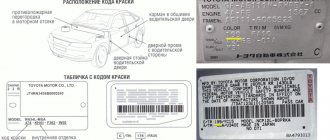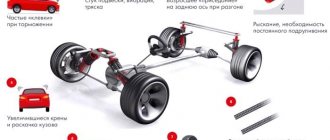Active sales of the seventh generation Camry started in the fall of 2011, so the oldest copies of the car are no more than nine years old. By the standards of the inexorably aging secondary car market in Kazakhstan, this is not so much. But over the years, the car has demonstrated a considerable bouquet of congenital and acquired problems, which, however, had little effect on its popularity.
1 / 4
1 / 4
On Kolesa.kz there are more than 20 thousand advertisements with spare parts for Camry
Body
The most vulnerable thing about the Camry 50 is, of course, the body, namely its paintwork. On average, a paint coating with a thickness of 100–120 microns has unsatisfactory durability, and if chips occur, it is not far from the first saffron milk caps.
1 / 5
1 / 5
The thin chrome plating of the decor also does not stand the test of time, and the low beam reflectors in the headlights quickly burn out. Taking into account the multiple price range between Toyota genuine parts and duplicates, many cars have had non-original parts for a long time. For example, if a factory windshield on a Camry 50 costs about 200 thousand tenge, then a copy costs 25 thousand, a similar proportion with halogen headlights and other things.
Where does the "red" on Toyota come from?
“Really, where does the saffron milk cap come from on a Toyota?” – the owner of a four-year-old unbroken Camry XV50 is indignant – “This didn’t happen on my previous almost ten-year-old “forty”!” The doors, hood, trunk lid - everything has red spots even if there are no chips. On top of that, the driver's door seal has made an oblong bald spot in the paint. It is obvious that the business car has “lost a lot of weight” both in the thickness of the paintwork and in its quality, in contrast to its predecessor. I can just imagine the head of production optimization: “Now we’ll reduce it here, cut it here, and no one will notice anything.”
Suspension elements also corrode quickly, but this is no longer so scary
But it became noticeable. Immediately after the model appeared in 2012, owners noticed that scratches appeared on the car too easily and the headlights quickly became cloudy. Does Toyota cooperate with polishers?
Many people liked the pearlescent color - it shimmers beautifully in the sun. The joy disappears when, after a minor accident, they find out the price for selecting enamel and repainting. Attempts to find a cheap service usually end in a complete rework, only somewhere in a premium studio or at a dealer.
It's normal to see misaligned body panels on a new Camry.
Engines
The ever-sweating valve cover of four-cylinder engines can be treated by replacing the gasket
Of the 2.0, 2.5 and 3.5 liter petrol engines available, buyers most often chose 2- and 2.5-liter units. This is not only because of the more affordable price and lower tax, but also because we have heard about the tendency of the top-end 249-horsepower V6 inherited from the “magpie” to overheat, followed by oil consumption and a drop in traction, which drivers with an aggressive style complained about ride. Therefore, in order to avoid consequences, it is necessary to monitor the condition of the pump and at the first alarming symptoms - noise and leakage - without a shadow of a doubt, change it, fortunately.
Two-liter engines were noted for the flimsiness of the thread for fastening the cylinder head in the aluminum block, forcing the driver to carefully monitor the proper operation of the cooling system and the cleanliness of the radiator and air conditioning condenser, so as not to suffer thermal shock. After 60–70 thousand kilometers, the water pump leaked on many cars, and after 150 thousand, the ignition coils could burn out. But the timing chain demonstrated miracles of inextensibility, not requiring replacement for a long time.
If you don't change the oil on time, you can end up with a lot of problems... VVT-i gears/couplings will be the first to crack
By the way, about the timing belt: it is the condition of the mechanism that you should pay attention to when choosing a version with a 2.5 engine. A cracking sound from the engine compartment when starting up indicates worn-out gears, which can lead to costly repairs with chain replacement costing from more than three hundred thousand tenge at a regular service station and over half a million at an official dealer. Also, do not forget to check the condition of the upper engine mount; there may be cracks there due to the load.
Nevertheless, with frequent maintenance, the entire rather conservative Camry 50 engine line confidently reaches 300 thousand km and continues to work further, which only strengthens the model’s reputation in the eyes of Toyota drivers. But already closer to 400 thousand, an engine overhaul is looming, inevitable due to coking of the oil scraper rings.
Transmission
Now let's look at how things stand with boxes. As you know, Camry 50 sedans finally got rid of mechanics, so they were equipped exclusively with Aisin automatic transmissions. There are no questions about the early four-speed unit U241E, supplied with a 2-liter engine - with careful use, the box will last up to half a million kilometers. The later six-speed U760E, paired with 2.5 engines, reach 250–300 thousand km, subject to timely oil changes and... quiet driving. By the way, slight vibration of these boxes, even when the car is stopped at a traffic light, is the norm.
Transmission seal leaks are far from uncommon.
Unfortunately, Aisin’s new six-speed automatic U660E, intended for the V6, turned out to be capricious and, during active driving, after the first shocks when switching, it can force the car owner to contact a service center to replace the torque converter. Moreover, the first symptoms of fatigue appear in the form of jerks and gas shifting when switching (especially from third to fourth gear) after only 40–60 thousand km.
The result of traffic light racing is uneven wear of the friction disc
Repairing a gearbox for a “fifty” is expectedly expensive and can cost 300–700 thousand tenge even from unofficials, and purchasing a contract transmission is still a roulette, so it will be more profitable to monitor its condition in everyday life.
Toyota Camry competitors
Contrary to many automobile publications, we assign “Koreans” in the form of the Hyundai i40 and Kia Optima to compete with the Toyota Camry XV50, which are practically not inferior to the famous Japanese sedan in either reliability or comfort, but the price on the used car market is much more interesting. Also worthy rivals to the Camry are the Mazda 6 and Ford Mondeo, which are expensive to maintain. Those who need a car that is even more comfortable can look towards the Volkswagen Passat or the Nissan Teana, which has left our unstable market.
Toyota Camry XV50 – VIN location and engine number
Suspension
The durable suspension with good energy capacity, originally adapted by Japanese engineers for problematic roads, serves almost without any complaints. Factory ball joints and shock absorber struts last up to 150-200 thousand km, so the struts and bushings of the front and rear stabilizers (fortunately, inexpensive) are the first to fail.
The presence of electric power steering allowed us to avoid all the hassle with power steering. On early cars, the only annoying thing was the creaking of the airbag coil in the steering wheel. First, the cable makes a squeaking sound when the steering wheel is rotated, then it frays and turns off the SRS, which is immediately signaled by a lit up icon on the dashboard.
The engine crankcase is a little low, it’s good that it’s made of steel. However, it is better to buy additional protection
What places should you pay attention to when purchasing?
When buying a “fifty”, you need to start your inspection with the condition of the body. In Russian winter conditions, chrome parts quickly become cloudy. Rust quickly appears in places where there are chips.
Particular attention should be paid to decorative trims and wipers - cracks appear on them and the varnish peels off. These defects may not be visible in photographs, but are apparent upon personal inspection.
The condition of the interior can tell you about the age of the car. The upholstery quickly begins to shine and tear. The skin becomes cracked.
When purchasing, you need to check the oil cooler pipe. It quickly fails, which leads to oil leakage. Front brake discs often become deformed due to overheating.
It is also important to check the number and condition of the “secrets”. If many of them are disabled, the car may be stolen. In this case, you need to carefully check the documents and legal purity.
Salon
Of course, comfortable and spacious, including for those sitting in the back, the Camry 50 interior cannot be called durable due to low wear resistance. After a few years of use, crickets appear everywhere, the plastic base of the central armrest bursts, and the fabric upholstery quickly loses its presentation. The driver's seat cushion sags, especially the side bolster, which requires the installation of a more elastic filler. By the way, problems with the seat and leather were resolved at one time under warranty. And there are also complaints about sound insulation: noise from the wheel arches forms a permanent background when driving on wrinkled asphalt.
1 / 4
1 / 4
Depressed state
Unlike its predecessor XV40, the interior of the “fifty” Camry looks solid and, dare I say it, representative. The truth is that complaints arise not at all about the appearance – but about the materials. When choosing used cars for people, you can observe how quickly the side of the driver’s seat is pressed down with the mileage traveled. For example, this is what the seat looks like after 25 tkm:
After 100 tkm, the seat cushion gives the impression that the car has gone through the entire 300 thousand. Therefore, for many dissatisfied people, the seat was replaced under warranty
By the way, this is what the steering wheel looks like after 200 tkm:
Most often, Toyota Camry XV50 owners are engaged in refining what should, in theory, be normal in a business-class car. I'm talking about sound insulation. The point is not even that a lot of vibrations pass into the cabin from the street. It’s just that over time, explosive plastic begins to produce ugly “music” that owners of more budget cars are used to listening to. The glove compartment does not show itself in the best light either, the fastenings of which break from slight overload. In general, you definitely can’t carry a weapon there - it will fall out at the most unfortunate moment in front of the traffic cop’s eyes.
The glove compartment latches are fragile. Do not load it with heavy objects











